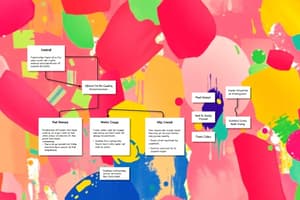Podcast
Questions and Answers
What is an activity diagram primarily used to describe?
What is an activity diagram primarily used to describe?
- Non-functional requirements of the system
- Dynamic aspects of the system (correct)
- Functional requirements of the system
- Static aspects of the system
What type of diagrams, along with use case and state machine diagrams, are activity diagrams considered to be?
What type of diagrams, along with use case and state machine diagrams, are activity diagrams considered to be?
- Behavior diagrams (correct)
- Structural diagrams
- Interaction diagrams
- Deployment diagrams
What is one of the benefits of using activity diagrams?
What is one of the benefits of using activity diagrams?
- To model the physical architecture of a system
- To simplify and improve a process by clarifying complicated use cases (correct)
- To create a new system from scratch
- To increase the complexity of a system
What is an example of a type of flow that can be depicted in an activity diagram?
What is an example of a type of flow that can be depicted in an activity diagram?
What is the primary purpose of using flowcharts?
What is the primary purpose of using flowcharts?
What can activity diagrams be used to describe, in addition to system behavior?
What can activity diagrams be used to describe, in addition to system behavior?
What is an activity diagram often referred to as?
What is an activity diagram often referred to as?
What can be modeled using activity diagrams, in addition to system behavior?
What can be modeled using activity diagrams, in addition to system behavior?
What is the purpose of a fork node in an activity diagram?
What is the purpose of a fork node in an activity diagram?
What do guards represent in UML?
What do guards represent in UML?
What is the purpose of using activity diagrams?
What is the purpose of using activity diagrams?
What is the notation used to represent the initial action state or start point in an activity diagram?
What is the notation used to represent the initial action state or start point in an activity diagram?
Flashcards are hidden until you start studying
Study Notes
Activity Diagram
- An activity diagram is a type of UML diagram that describes the dynamic aspects of a system, representing the flow from one activity to another.
- It is a visual representation of a series of actions or flow of control in a system, similar to a flowchart or a data flow diagram.
Key Features
- Activity diagrams deal with all types of flow control, including sequential, branched, and concurrent flows.
- They use different elements such as fork, join, and decision nodes to represent complex flows.
Benefits
- Activity diagrams help demonstrate the logic of an algorithm, describe the steps in a use case, and illustrate business processes or workflows.
- They simplify and improve processes by clarifying complicated use cases and model software architecture elements.
Difference from Flowcharts
- Flowcharts are a primitive version of activity diagrams, used by non-programmers to model workflows.
- Activity diagrams are used by developers to depict workflows, understand the flow of programs, and figure out constraints and conditions.
Notations
- Initial State/Start: a small filled circle followed by an arrow, representing the start point of an activity diagram.
- Activity or Action State: a rectangle with rounded corners, representing a non-interruptible action of objects.
- Action Flow: an arrowed line, illustrating the transitions from one action state to another.
- Decisions and Branching: a diamond, representing a decision with alternate paths, labeled with conditions or guard expressions.
- Guards: a statement written next to a decision diamond, specifying a condition that must be true before moving to the next activity.
- Synchronization: a fork node, used to split a single incoming flow into multiple concurrent flows, and a join node, joining multiple concurrent flows back into a single outgoing flow.
Studying That Suits You
Use AI to generate personalized quizzes and flashcards to suit your learning preferences.




